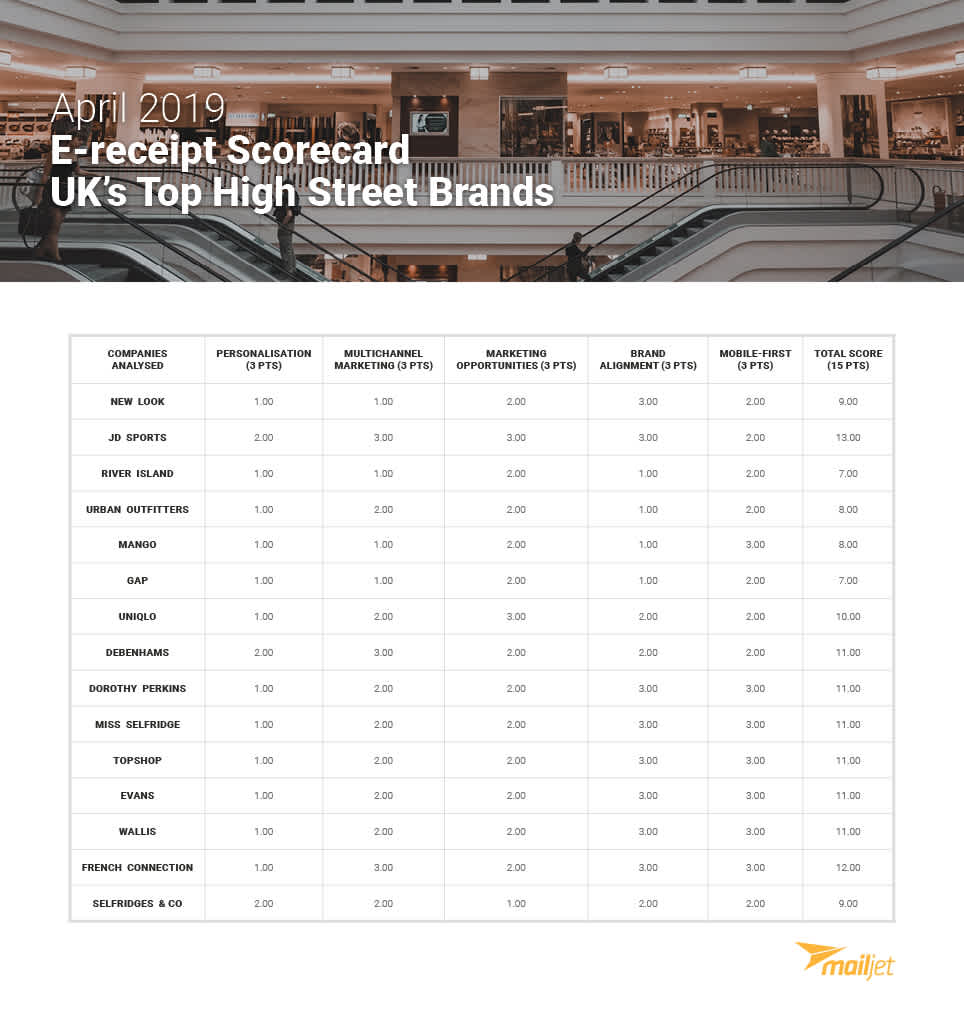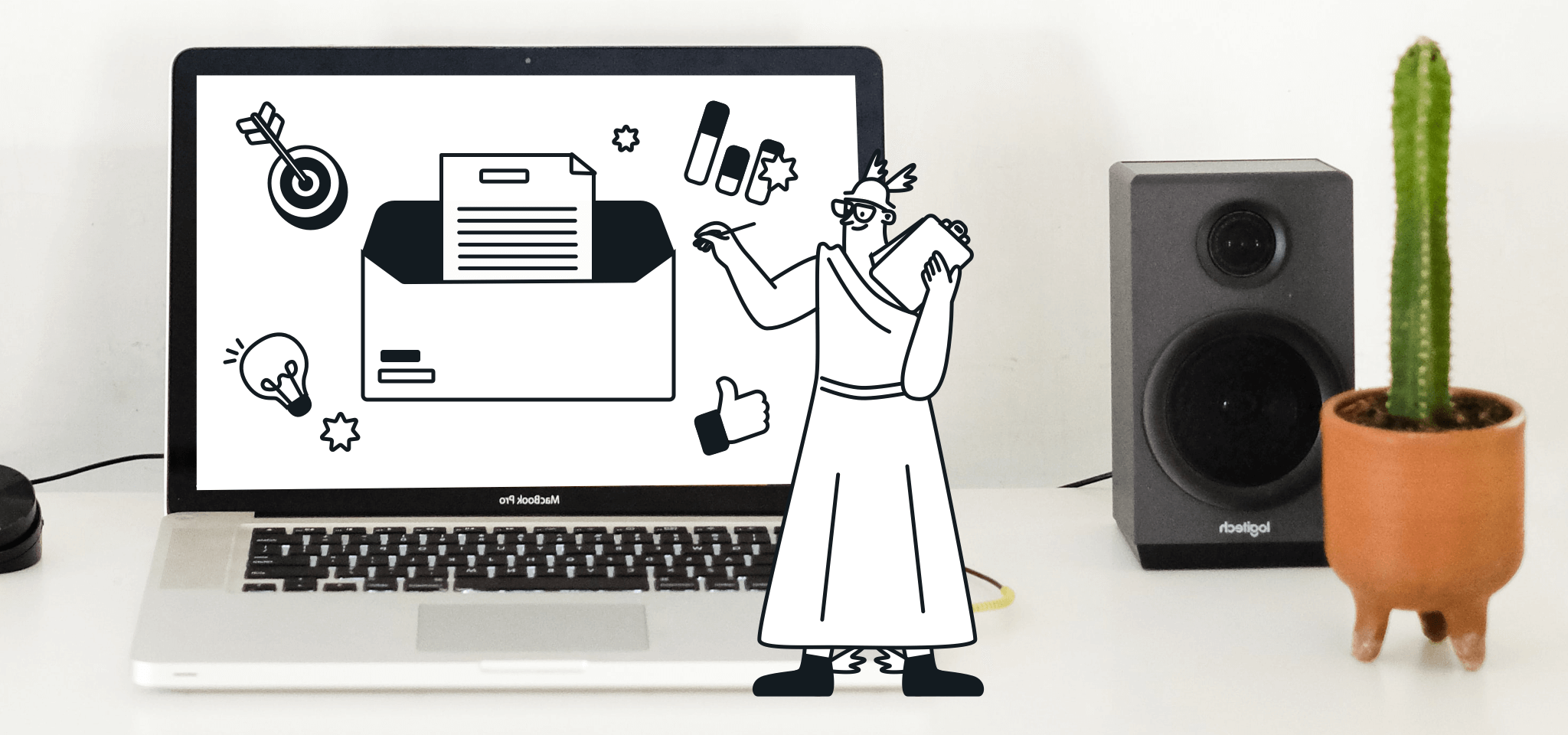Email Best Practices
What’s a sustainable alternative to paper receipts?
In the U.K., brands print around 11.2 billion receipts each year, costing at least £32 million. However, companies are steadily switching from paper to digital receipts to reduce their carbon footprint.

PUBLISHED ON
In a research study, Mailjet found that 15 of the U.K.’s top 30 high street clothing labels fail to offer any kind of e-receipt to customers when shopping within their physical stores.
Brands spend at least £32M on printing 11.2B receipts in the U.K. Despite the boom in headlines around sustainability brought on by David Attenborough’s “Climate Change – The Facts” documentary, it appears that half of the U.K.’s high street brands and retailers are still reliant on physical receipts for every purchase.
Among the best-in-class, Uniqlo, Dorothy Perkins, and Evans proactively promote sending customers e-receipts via signs or tablets in-store. In all other cases, customers received e-receipts after they specifically requested them.
Survey testers opted to receive eco-friendly e-receipts at all 15 stores where they were available. The study then analyzed the e-receipt emails received and scored them according to a range of direct marketing metrics including personalization, shoppability, brand alignment, and data privacy compliance.
Despite the rising awareness of sustainability among consumers, 50% of high street brands still have no paperless option.
The other 50% of brands that have a sustainable alternative utilize customer surveys and social sharing to enhance the customer experience.
Data compliance is a priority for paperless receipts, yet some brands are falling short.
Table of contents
Digital receipts
Paper receipts
Methodology
List of brands included in the research (both those who did and didn’t send e-receipts)
Scoring criteria
Sustainability and consumer engagement
While many brands initiate the shift to e-receipts for ecological reasons, they’re also exploring new ways to leverage this format. Every brand tested – except JD Sports, Mango, and Selfridges – included a customer survey within their e-receipts. New Look, Dorothy Perkins, Miss Selfridge, Topshop, Evans, Wallis, and Urban Outfitters all offered rewards and incentives in exchange for feedback on their in-store shopping experience.
Many brands also capitalize on the opportunity to direct customers to other marketing-friendly channels. Under the “multichannel marketing” category, JD Sports scored full marks for including a phone number, email, and dedicated Twitter handle, alongside social media and app links. Debenhams and French Connection also received top marks for including store locators and social links.
Playing by the rules
A hot topic associated with e-receipts is how to harmonize them with data privacy. This includes clearly informing clients about how their data will be used and ensuring they aren’t automatically opted into any other marketing communications or unsolicited emails for which there’s no specific consent or legitimate interest.
Positively, most brands surveyed offered some sort of information regarding the use of the data captured from customers. Evans, Wallis, Uniqlo, and Dorothy Perkins – the leaders in this category – have been offering clear signs or information at the store level. Some brands – including JD Sports, Mango, and New Look – also followed up with information in the e-receipt about how data would be used.
Unfortunately for the high street, several brands still failed to include clear information on data usage in the e-receipt. In some cases, this information was only provided by asking directly at the till or not provided at all.
More surprisingly, it seems that many marketers still can’t let go of the mindset that the larger your email list is (opted-in or not), the better. The study exposed that some high street brands followed up their e-receipts with unsolicited marketing emails, an activity that might put them at risk of non-compliance with the General Data Protection Regulation (GDPR) if brands can’t ensure that there’s a legitimate interest, i.e., a clear link between email promotion and users’ purchases.

Reasons to switch from paper to digital receipts
Global deforestation: Although a thermal receipt is a small piece of paper, each one further contributes to global deforestation. Paper receipts are the reason behind cutting more than 25 million trees annually, leading to additional environmental impacts like the depletion of habitats, increased greenhouse gas emissions, and endangered species.
Costs: Paper receipts cost money, creating an additional expense that takes away from profits. With a shortage of leuco dye used in printing, the cost of receipts is expected to increase until 2025. If brands provide customers with an option of an e-receipt, they’ll not only save paper and the planet, but also reduce expenses.
Toxic chemicals: Although paper receipts may appear harmless, they contain harmful chemicals. During printing, thermal paper coated in bisphenol-A reacts with heat to display purchase information. Bisphenol-A is a toxic substance responsible for many adverse health problems and is currently prohibited from products like water bottles and children’s toys.
Inconvenience: As technology advances on a daily basis, paper receipts are becoming a thing of the past. With everything from music to credit card statements stored in the cloud, electronic receipts just make sense. If you’re a business owner, paper receipts are hard to keep track of and organize and are easily misplaced.
How does this impact your business?
Digital receipts give your business a competitive advantage. For example, you can reduce expenses, improve convenience for customers, enhance health and safety measures, and show a commitment to the planet.
When you move to electronic receipts, there’s no need to purchase thermal paper, printing machines, and other associated supplies, increasing both convenience and your bottom line. Besides, it’s always nice to know there are fewer toxic chemicals around, like bisphenol-A, which may be a health risk to employees and consumers. Using digital receipts shows your company’s attention to environmental issues and efforts to reduce its carbon footprint.
Digital vs. paper receipts: Pros and cons
Digital receipts
Pros:
Always available via electronic devices
Great for cloud accounting
Typically free to offer via electronic point of sale (EPOS) systems
Cons:
May have to ask for customers’ phone numbers and email addresses
Explaining digital receipts to customers who want paper versions
Paper receipts
Pros:
Might be faster in some cases
Don’t have to ask for phone number/email
Cons:
Usually aren’t recyclable
Pose health concerns
Easy to misplace, and fades over time
Increases cost of supplies
How have things changed?
With increasing awareness around climate change and the need to reduce carbon footprint, switching from paper to digital receipts is a step in the right direction. Not only do electronic receipts drastically reduce waste, but they also help preserve existing forests.
However, paper use remains strong globally, with more than 400 million tons set for production in 2022. Since 2019, cardboard use has increased, while printing and writing paper experienced the opposite effect. The chart below shows the trends and changes in paper use over the years.
All in all, electronic receipts can help reduce these figures, all while helping companies lower their costs and keep more accurate records. They’re simply a better solution than paper receipts.

About the research
Methodology
A team of email experts analyzed e-receipts sent by 15 leading high street brands and retailers in the UK in March 2019. Each email was individually scored according to how well it met the below criteria (e.g., scoring system: 3.0 = best possible score, 1.0 = worst possible score). The average result was then calculated for each candidate.
List of brands included in the research (both those who did and didn’t send e-receipts)
& Other Stories, Bershka, Debenhams, Dorothy Perkins, Evans, Footlocker, Forever 21, French Connection, Gap, H&M, House of Fraser, JD Sports, John Lewis & Partners, Marks & Spencer, Mango, Matalan, Miss Selfridge, Monsoon, New Look, Next Primark, Pull & Bear, River Island, Selfridges, Sports Direct, Topman & Topshop, Uniqlo, Urban Outfitters, Wallis, and Zara.
Scoring criteria
Measured data privacy compliance: Clear information on how the data would be used; no forced opt-ins to marketing emails.








